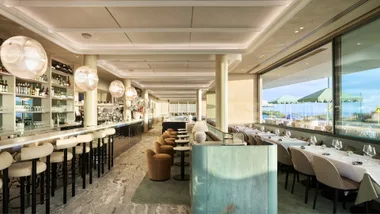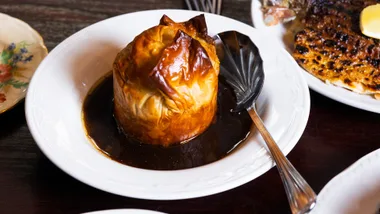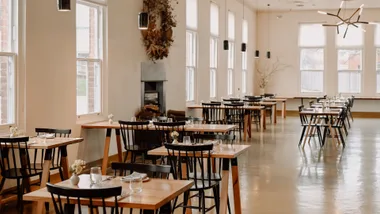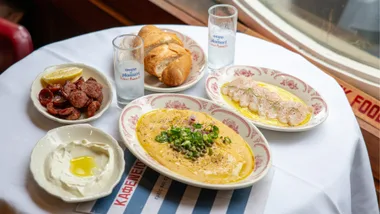Fred’s
380 Oxford St, Paddington, (02) 9240 3000, merivale.com.au
Licensed
Open Tue-Sun 5.30pm-9.30pm; Fri-Sun 12pm-2.30pm
Cards AE MC V EFT
Prices Entrées $26-$42, main courses $42-$135, desserts $11-$18
Vegetarian With notice
Noise Noisy
Wheelchair access No
Minus The cocktail bar
Plus Everything else
Fred’s is one of the most likeable restaurants to have opened in Sydney in years. It’s had a considerable amount of time and money lavished on it, and has the power of a large restaurant group behind it, yet it’s steered with the nimble finesse of something more intimate. It has personality. It takes rare vision and serious investment to build a dining room this lovely – a sort of Chez Panisse for the eastern suburbs of Sydney, the tables not so much viewing an open kitchen as part of it, extending out from the hearth. It’s a combination of artistry and fine-grained technical skill that’s rarer still, though, that makes it sing. Vladimir Nabokov once said that a writer should have “the precision of a poet and the imagination of a scientist”. Chef Danielle Alvarez is a precise poet, and the sweet science of her cooking at Fred’s will capture your imagination.
.jpg?resize=877%2C1024)
The kitchen.
Think of the food as a postcard from the Mediterranean sent to Sydney via California. Whispers of long lunches under olive trees on the Riviera, the splash of the waves, the distant scream of cicadas and the scent of sun-baked rock, all transported to Oxford Street. Cannes without the Russian mafia, Nice without the traffic, St-Tropez with food that doesn’t suck.
It’s a place where zucchini becomes a sweet treasure by virtue of its careful selection, where deft fingers tie coral trout in fig leaves with string, where the fish for the kitchen have been caught wild and the beasts have been raised and killed with care by friends of the cook.
Good times are the default setting at Fred’s, not hauteur. Diners are made to feel like they’re guests looked after by the kitchen rather than being the subjects of its experiments. Its treasures are not sturgeon eggs and foie gras and the chilly trinkets of the nouveau-riche larder, but the fruits of the farmhouse and the harvest, apple freshness, butter sweetness and the amber purity of honey.
After a hard day of the virtual it feels, dare I say it, wholesome, and the broad and handsome planks lining the floor at Fred’s, the cool stone of its benchtops and the loose weave of the linen napkins are a balm to the soul-numbing torpor of touchscreen modern life. Uncluttered but rich in detail, the design shuns the monastic-industrial look without swinging too far the other way. None of your Laura Ashley-goes-to-the-Hamptons here.
.jpg?resize=877%2C1024)
Moorlands lamb with summer herbs, crumbed eggplant and charred capsicum.
There’s an epic array of large, expensively old-looking breadboards on one wall that I’d guess would fetch $26,000 up on the mean streets of Woollahra, for instance, but they’re displayed off to the side rather than as a centrepiece. The quiet elegance of the type on the menu is matched by the unshowy cool of the jazz on the playlist. There’s a well thought-out sturdiness to the whole caper and the way the pieces fit together. It gives an intimation of substance without self-seriousness in a way that is terribly appealing and adult. It feels cosy and welcoming without giving up on the possibility of being sultry.
You might say the same thing about the hors d’oeuvre. They could be little panisses – chickpea chips in lesser hands – with shavings of cheese, or tiny green tomatoes topped with curd. Another night it’ll be slivers of bread freighting crème fraîche, pickled radish and salmon eggs that have been briefly marinated in sake. They’re not showy and they’re presented with a casual air, but the impact of their flavour and freshness is the result of genuine consideration and effort.

The seamless kitchen-dining room.
Alvarez hails from Miami. Her parents are from Cuba, but there’s precisely nothing overtly Cuban-American about her cooking here. She also worked at The French Laundry in the Napa Valley, but if you were looking for traces of Thomas Keller in her work, it could be that his famed rigour made more of a lasting impression on Alvarez than his menu choices did. No, Alvarez was hired from Chez Panisse, the restaurant in Berkeley where restaurateur Alice Waters did as much to forge an identity and style for West Coast cooking as anyone, and it’s to that produce-driven, Mediterranean style that Alvarez remains true. The kitchen was designed from the ground up with this in mind, and then the restaurant was built around that, so the whole thing flows from the hearth. It’s not quite as serious as Firedoor – no axes or bandsaws in sight – and while it’s less edgy than, say, Ester, it also happens to be a lot more comfortable.
Alvarez is a whiz with fruit and vegetables, but boy can she cook meat. I don’t think Sydney has seen a more impressive lamb dish in recent memory than her roast. It’s essentially meat and three veg, no tricks, no bells, no whistles. Alvarez likes to use produce from smaller farms; she gets her lamb from Moorlands, a well-regarded producer in the Southern Tablelands, and she handles it with great confidence. You’re served slices cut from the loin and leg that have been roasted on the bone on the hearth. Some days she’ll do the leg à la ficelle – that is, hung over the hearth by the shank, turning on a piece of string over the heat of the coals like a MacGyver rôtisserie. Whatever her method, she pulls a huge amount of flavour from the meat, pairing it with broad beans, grilled gem lettuce, artichokes and a light, clever sauce made with laver, the seaweed we know best in Australia as nori.
.jpg?resize=877%2C1024)
Bucatini with sardines and fennel.
Alvarez is not doctrinaire in her selection of ingredients, slipping in the occasional Asian element in a manner that’s perfectly seamless. That subtle splash of sake on the salmon roe, say, or the savoury richness brought to grilled baby artichokes by oil flavoured with kombu. She gives depth to the vinaigrette that dresses new potatoes and fine herbs with black garlic, while kaffir lime butter and fresh turmeric might colour the grilled king prawns. This is a kitchen where herbs are deployed with a painterly touch. Chamomile accents a macadamia meringue served with strawberries heavy with perfume, while oregano gives just the right twang to triangoli – lush triangular ravioli filled with smoked potato and sauced with roasted cherry tomatoes.
Order the pasta. Alvarez enriches a nicely coarsecut ragù of rabbit and peas with a splash of whey. One day she’ll lighten up the plate with tender broad bean leaves, another it’ll be society garlic. Strands of fresh bucatini loll fat and happy in a Sicilian-leaning sauce of sardines, toasted breadcrumbs and fennel brightened with currants and saffron.
The atmosphere is exceedingly pleasant. On a good day there’s a convivial roar that isn’t quite deafening, and the collar-popped yahoos you sometimes see at The Paddington next door seem less a feature here. It’s like being at a dinner party, only you happen to have invited your most attractive friends, and the kitchen and dining room got made over into a 21st-century version of a French farmhouse when you weren’t looking.
-scaled.jpg?resize=877%2C1024)
Interior.
And most days at Fred’s are good. The Merivale group, which owns the restaurant, has expanded at a cracking pace over the past few years, taking over big pubs in Coogee, Newport and the inner west. Keeping its numerous bars and eateries stocked with staff of a calibre commensurate with its pricing must be a challenge. The consistent quality of the service at Fred’s suggests they’ve worked harder than ever to get this one right. Carissa Teeling, one of the group’s least flappable and most polished performers, runs the restaurant with admirable style, while Caitlyn Rees, who stepped into the head sommelier role after working wine at the likes of Momofuku Seiobo and The Wine Library, matches impressive knowledge of a real corker of a list with a disarming enthusiasm. If you want something interesting, she might suggest kicking off with a riesling from Clare Vally producer Koerner – its richness makes for a delicious departure from the region’s austere reputation while it maintains freshness and minerality. If you’re looking for Champagne, Burgundy or Bordeaux and you’re happy to pay for it, you’ll find worthy prey, but there’s also much to like in the way of lesser-known regions, and plenty of it is available by the glass.
.jpg?resize=877%2C1024)
Working the hearth.
Ingredients that taste of themselves. Food that’s served hot. The smell of things being cooked to order. It’s not rocket science, but it works. And it’s just not that easy to come by in Sydney 2017, which might explain why it’s so tough to land a booking, even when the prices are unquestionably serious – entrées are north of $26, while the main courses top out at $135 for a 600-gram piece of Robbins Island beef from Tasmania, roasted for two. Dessert keeps the core mission of real textures and natural flavours to the fore with rustic elegance in the form of a rhubarb and frangipane tart paired with a crème pâtissière shot through with the honeyed tones of Beaumes de Venise muscat.
Cost aside, there are few downsides to Fred’s. I’m not in love with the bar downstairs, Charlie Parker’s. It’s comfortable enough, and the look – something like an apothecary shop opened in a fallout shelter by a forgetful professor who loves the sea – is attractive. And with the focus on provenance upstairs, the conceit of the cocktail being all about plants shouldn’t be too much of a stretch. But it doesn’t quite work for me. There’s something creaky about the $19 drinks with their infusions of peas and grasses. The eye-threatening ikebana garnishes turn a cocktail into an exercise in trying to drink out of a vase. It’s effortful and fussy in a way that the offerings in the restaurant aren’t, and just not that rewarding. You could, however, spend a happy hour there with the wine list, and work your way through the bar menu. The superb little fingers of house-baked bread topped with rounds of radish and draped with fillets of anchovy are an ideal place to start.
.jpg?resize=877%2C1024)
Rhubarb and frangipane tart.
The main thing that will get in the way of anyone’s enjoyment of Fred’s is the simple challenge of landing a table. News that Fred’s takes bookings like a good old-fashioned restaurant will be welcomed by traditionalists, but the flipside is that walk-ins aren’t easy and prime-time tables book up well in advance. It’s a good problem for a restaurant to have.
The look echoes the feel which echoes the food that tells the story, and the story is this: products of great quality sourced with care are deployed with taste in the service of conviviality. Danielle Alvarez has plenty to say, but doesn’t feel the need to shout. At Fred’s the people are listening.
.jpg?fit=900%2C1051)










